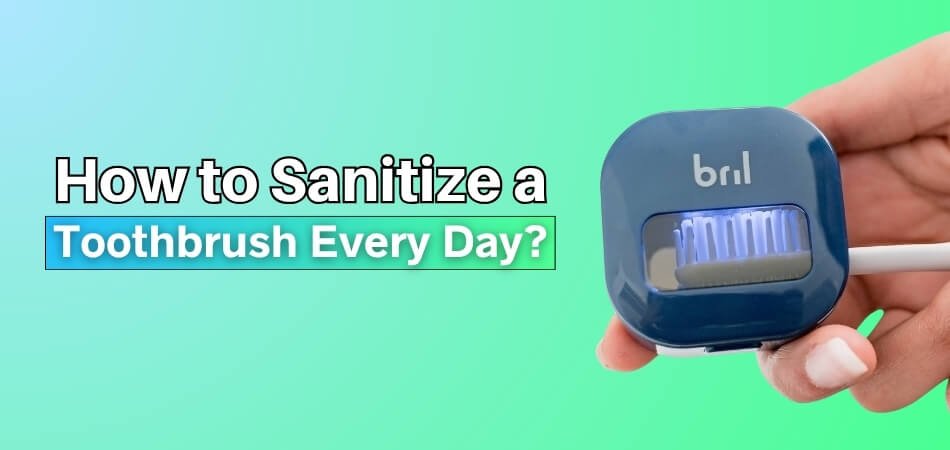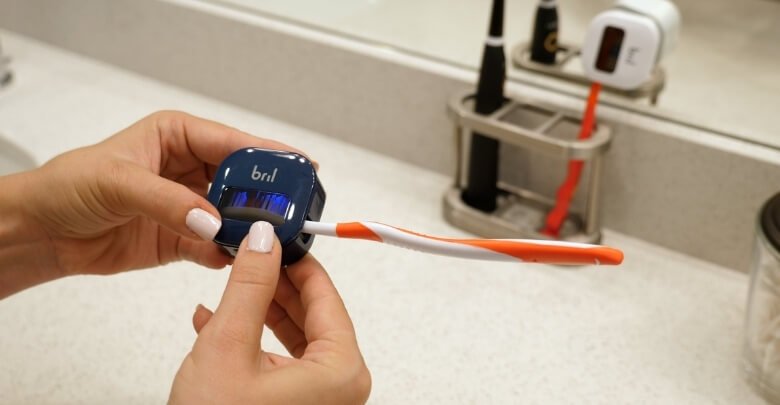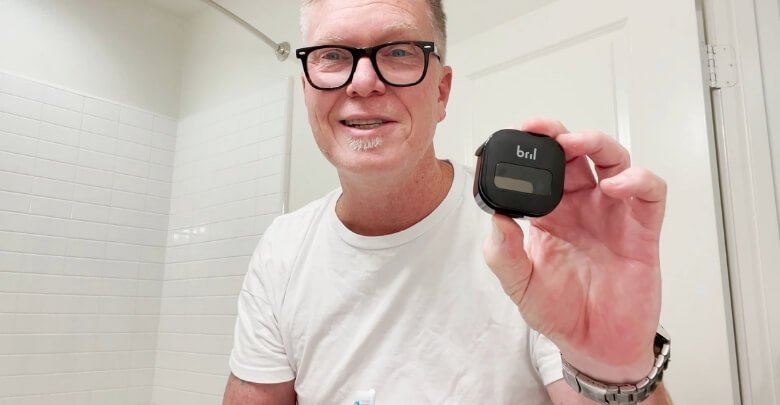We often focus on brushing twice a day, but rarely think about the tool itself, the toothbrush. Studies show that it can harbor millions of bacteria, especially if it’s left damp or stored carelessly. That makes keeping it clean just as important as brushing itself.
So, how to sanitize a toothbrush every day? The answer is simpler than most imagine. A proper rinse, safe soaking methods, or using modern UV sanitizers can reduce bacteria by over 99%. These quick steps ensure your toothbrush remains safe, effective, and ready to protect your oral health.
Daily toothbrush hygiene doesn’t take much effort, yet the benefits are huge: fresher breath, healthier gums, and stronger protection against illness. Continue reading to discover practical, step-by-step ways to keep your toothbrush truly clean each day.
How to Sanitize a Toothbrush Every Day?
Toothbrushes often carry millions of unseen germs that water alone cannot wash away. Daily sanitation keeps bacteria, viruses, and fungi from spreading into your mouth, lowering the risk of infections and bad breath. Whether you use home remedies or a UV sanitizer like Bril, a consistent routine ensures your toothbrush is safe for every use.

Step 1: Rinse Thoroughly After Each Use
Always rinse the toothbrush head under warm running water for several seconds. This clears away food debris and leftover toothpaste. Shaking off the water reduces moisture, which otherwise gives bacteria a chance to multiply on damp bristles between brushings. It’s the first step in keeping your brush cleaner.
Step 2: Avoid Common Cleaning Mistakes
Many people store brushes in closed containers while still wet or only rinse quickly with cold water. Others wait too long to replace a worn brush. These habits can trap bacteria instead of removing them. Avoiding these mistakes makes your cleaning efforts much more effective and long-lasting.
Step 3: Soak or Disinfect Regularly
Use an antibacterial mouthwash, diluted hydrogen peroxide, or even a baking soda solution to soak your toothbrush head for a minute or two. For deeper sanitation, some people dip brushes in boiling water briefly. Each of these methods kills bacteria more effectively than rinsing alone.
Step 4: Use a UV Sanitizer for Extra Protection
Devices like Bril use UV-C light to eliminate up to 99.9% of germs within minutes. Unlike rinsing or soaking, UV chambers target hidden bacteria that hide deep inside bristles. As mentioned in most Bril review, users find this method not only more effective but also more convenient for everyday hygiene.
Step 5: Store the Toothbrush Properly
Keep your toothbrush upright in an open holder so air can circulate and the bristles dry quickly. Avoid letting it touch other toothbrushes, as this spreads germs easily. If you use a UV chamber, you can safely leave it inside, as the device maintains a clean environment around the brush head.
Sanitizing a toothbrush every day takes only minutes but makes a big difference for oral health. From simple rinsing habits to advanced UV technology, each step helps reduce bacteria before they reach your mouth. Choose the method that suits you best and make it part of your daily routine for a fresher, healthier smile.
Why Daily Toothbrush Cleaning Is Important?
Your toothbrush may look clean after rinsing, but research shows it can harbor millions of bacteria. Without daily cleaning, those germs can travel back into your mouth and increase health risks. Proper sanitation prevents oral problems and ensures every brushing session is safe and effective. Here are the main reasons daily cleaning matters:
Prevent Bacteria Buildup
Each brushing session leaves behind food particles, moisture, and bacteria that thrive in warm, damp conditions. If not removed, these germs multiply quickly, creating a breeding ground for harmful microorganisms. Regular sanitation stops this buildup, ensuring your toothbrush doesn’t become a source of recurring oral health issues.
Reduce Risk of Gum Problems
Bacteria living on bristles can easily spread to your gums, leading to irritation, inflammation, and even infections like gingivitis. Over time, poor brushing hygiene increases the risk of periodontal disease. Daily cleaning lowers this exposure and supports healthier gums, giving your oral care routine a stronger protective effect.
Prevent Bad Breath
Unclean toothbrushes can trap bacteria that cause unpleasant odors. When used repeatedly without proper sanitation, they can worsen halitosis instead of improving it. By disinfecting your toothbrush daily, you eliminate odor-causing bacteria and ensure your mouth feels fresher after every brushing session.
Protect Overall Health
The mouth is connected to the rest of the body, which means bacteria from a dirty toothbrush may contribute to broader health concerns. Studies link poor oral hygiene to heart disease, respiratory infections, and weakened immunity. Daily sanitation acts as a small yet powerful step to safeguard your overall well-being.
Cleaning your toothbrush every day is more than just a hygienic habit — it’s an investment in your long-term health. By stopping bacteria before they reach your mouth, you protect your teeth, gums, and even your body from unnecessary risks. A few minutes of care can save you from bigger problems later.
Common Mistakes People Make While Cleaning Toothbrushes
Many people assume a quick rinse is enough to keep toothbrushes clean, but small mistakes in daily habits can reduce hygiene and make germs harder to control. Knowing these common errors and how to fix them helps you keep your toothbrush effective for longer and safer for your oral health.

Rinsing Too Quickly
A fast rinse with cold water won’t remove all bacteria or leftover toothpaste. Instead, hold the toothbrush under warm running water for several seconds and gently rub the bristles with your fingers. This ensures debris is cleared before moving on to deeper sanitizing steps.
Storing While Still Wet
Placing a toothbrush in a closed container immediately after use traps moisture and encourages bacterial growth. The better option is to store it upright in an open holder, allowing bristles to dry naturally with airflow. This prevents germs from multiplying between brushing sessions.
Waiting Too Long to Replace Brushes
Using the same toothbrush for too many months allows worn bristles to harbor bacteria and clean less effectively. Dentists recommend replacing brushes or heads every three months, or sooner if bristles fray. Combining timely replacement with daily cleaning ensures better oral protection.
Using Harsh Cleaning Chemicals
Some people use strong bleach or abrasive cleaners, thinking they’ll sanitize better. However, harsh chemicals can damage bristles and even pose health risks if residue remains. A safer choice is mild antibacterial solutions, mouthwash, or UV sanitizers that clean without weakening the toothbrush and also help remove toothbrush fungus effectively.
By avoiding these simple mistakes, you’ll keep your toothbrush both clean and durable. Small changes like drying it properly, replacing it on time, and using safe sanitizing methods make all the difference in maintaining effective daily oral hygiene.
Using Technology: UV Sanitizers and Alternatives
While rinsing and soaking methods help, modern tools like UV sanitizers provide a stronger layer of protection against hidden germs. These devices use light or portable designs to simplify hygiene, making them popular for both home and travel. Comparing them with home remedies shows why they’re becoming the go-to option for many households.
UV Sanitizers for Deep Cleaning
UV-C light sanitizers, such as Bril, kill up to 99.9% of germs in just minutes. Unlike rinsing or boiling, they target bacteria hiding deep in bristles. Many devices also include auto shut-off features and compact designs, making them reliable for daily use without adding extra effort to your routine.
Portable Travel Sanitizers
Travel-friendly sanitizers offer convenience when away from home. They are lightweight, compact, and often USB-rechargeable, ensuring your toothbrush remains germ-free in hotels or public bathrooms. Compared to soaking solutions, travel sanitizers are mess-free and protect against both airborne germs and cross-contamination while on the move.
Alternatives to UV Technology
For those without access to UV devices, simple alternatives like soaking in mouthwash, hydrogen peroxide, or boiling water are still effective. However, these methods require more time and care, and they don’t provide continuous protection once the brush is stored. UV sanitizers, by contrast, maintain cleaner conditions even between uses.
Modern sanitizing tools make daily hygiene safer and more convenient than ever. Whether it’s a compact UV chamber at home or a travel sanitizer on the go, these devices outperform traditional methods by saving time and ensuring deeper protection. Many readers also ask about the Bril toothbrush sanitizer price, as affordability combined with reliable UV cleaning makes it one of the most attractive options available.
Storing Your Toothbrush Correctly After Cleaning
Cleaning your toothbrush is only half the job; storing it the right way ensures it stays germ-free until your next use. Poor storage can undo your sanitation efforts by allowing bacteria to grow again. Following a few simple practices helps keep your toothbrush fresh, dry, and safe for long-term use.
Step 1: Keep It Upright
Place your toothbrush in an upright holder after cleaning. This position allows water to drain away from the bristles, preventing a damp environment where bacteria thrive. Holders with separate slots work best, as they keep brushes from tipping and collecting residue at the base.
Step 2: Allow Proper Airflow
Good airflow is essential for quick drying. Store your toothbrush in an open container rather than a closed cap or case, which can trap moisture. Open air circulation helps bristles dry naturally, reducing the chance of bacterial regrowth after sanitation.
Step 3: Avoid Contact With Other Brushes
If multiple toothbrushes are stored together, make sure they don’t touch each other. Direct contact can transfer bacteria from one brush to another, especially in shared bathrooms. Use a holder with spaced slots or individual covers that don’t trap moisture.
Step 4: Keep It Away From Germ Sources
Avoid storing your toothbrush near the toilet or sink splash zone. Airborne particles can contaminate bristles when left too close. Placing it higher on a shelf or inside a wall-mounted sanitizer keeps it cleaner and out of reach of bathroom bacteria.
Storing your toothbrush correctly extends the benefits of cleaning and ensures your efforts aren’t wasted. Upright placement, proper airflow, and safe distancing from other brushes make a significant difference. By adopting these habits, you’ll maintain a consistently fresh and hygienic toothbrush every day.
Dentist-recommended Practices for Brush Hygiene
Dentists emphasize that toothbrush care is just as important as brushing itself. A well-maintained brush prevents bacteria transfer, supports gum health, and ensures effective cleaning. Following expert guidance makes it easier to build habits that protect both your oral hygiene and your overall health. Here are some practices dentists recommend:

Replace Your Toothbrush Regularly
Most dental experts advise changing your toothbrush or brush head every three months. Bristles wear down and lose cleaning power over time, and they also collect bacteria. Replacing your brush on schedule ensures effective cleaning and reduces the risk of spreading germs to your mouth.
Avoid Sharing Toothbrushes or Sanitizers
Dentists strongly warn against sharing toothbrushes or sanitizing devices with others. Even within families, cross-contamination can spread bacteria, viruses, and infections. Always use your own brush and keep it separate from others. If you use a sanitizer, make sure each person has their own dedicated space.
Make Cleaning Part of Your Routine
A toothbrush should be sanitized daily, just like it is used daily. Experts recommend rinsing thoroughly, disinfecting regularly, and storing properly after each use. Consistency matters more than occasional deep cleans, as daily habits prevent bacterial buildup and help maintain a healthier brushing experience over time.
Keep Brushes Stored Safely
Proper storage reduces contamination risks. Dentists recommend placing toothbrushes upright, allowing bristles to air dry, and keeping them away from toilets or sinks. This simple habit keeps brushes fresher between uses and ensures you aren’t reintroducing germs into your mouth during brushing.
Dentist-recommended hygiene practices are easy to follow yet highly effective in protecting oral health. From replacing brushes on time to cleaning them daily and storing them safely, small steps create long-term benefits. Building these habits into your daily routine ensures a cleaner toothbrush and a healthier smile.
Frequently Asked Questions
After learning how to clean and store your toothbrush daily, you may still have a few curiosities. Here are some common questions readers often ask when it comes to toothbrush hygiene and safety.
Can Toothbrushes Spread Colds or Flu?
Yes, toothbrushes can carry viruses like the cold or flu if not sanitized. Sharing brushes makes this risk even higher. That’s why cleaning and storing your toothbrush properly is so important.
Should I Cover My Toothbrush While Traveling?
It’s okay to cover your toothbrush during travel, but only after it’s completely dry. A wet brush in a closed case can grow bacteria. Consider travel sanitizers for extra protection.
Can Kids Use UV Toothbrush Sanitizers?
Yes, children can safely use UV toothbrush sanitizers. These devices are designed to sanitize without chemicals. Just ensure the sanitizer fits the child’s brush size and is used under parental guidance.
Does Water Temperature Matter When Rinsing?
Yes, warm water is better than cold for rinsing a toothbrush. It helps loosen debris and wash away germs more effectively. However, avoid extremely hot water, as it may damage the bristles.
How Do I Know If My Toothbrush Is Still Clean?
If your toothbrush smells odd, looks discolored, or has frayed bristles, it’s no longer clean. Even after sanitation, replace it if these signs appear. A clean toothbrush should look and smell fresh.
Can I Sanitize My Toothbrush in a Dishwasher?
No, dishwashers are not safe for toothbrushes. High heat and detergents can weaken bristles and make the brush less effective. It’s better to use safe methods like rinsing, soaking, or UV sanitizers.
Are Bamboo Toothbrushes Harder to Keep Clean?
Bamboo toothbrushes can hold more moisture than plastic, making them slightly harder to dry. With proper storage and regular sanitizing, they stay clean. Just remember to replace them on the same schedule.
Concluding Lines
Taking care of your toothbrush is just as important as brushing itself. A brush filled with germs can undo the effort you put into daily oral care. That’s why learning how to sanitize it properly matters.
When it comes to How to Sanitize a Toothbrush Every Day, the methods are simple. From rinsing thoroughly and avoiding storage mistakes to trying UV sanitizers, these steps don’t take much time but make a big difference for your health.
By making sanitation a daily habit, you’re not only keeping your brush clean but also protecting your smile and overall well-being. Start applying these small steps today, and enjoy the confidence of knowing your toothbrush is always fresh and safe to use.






